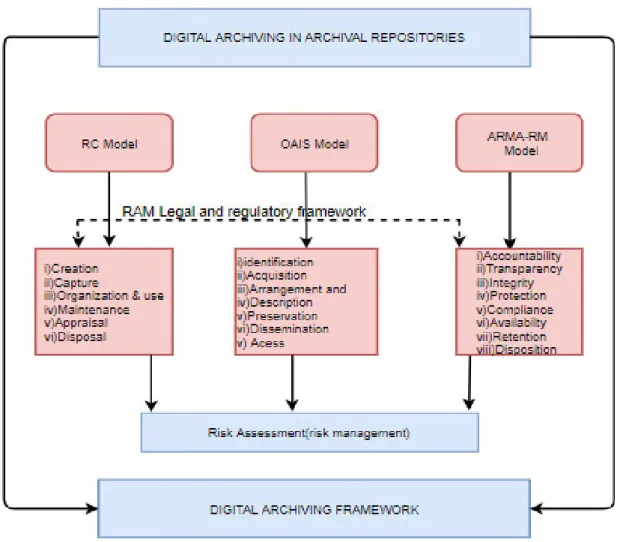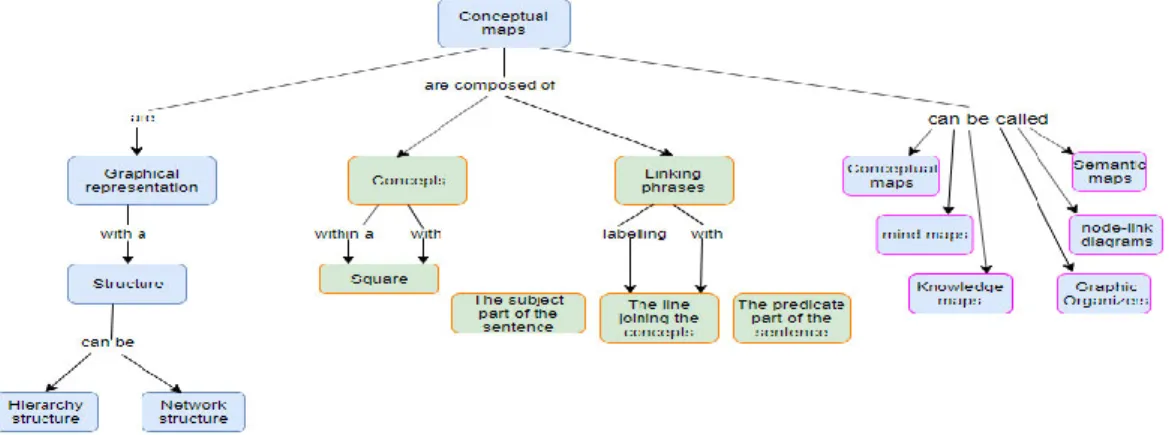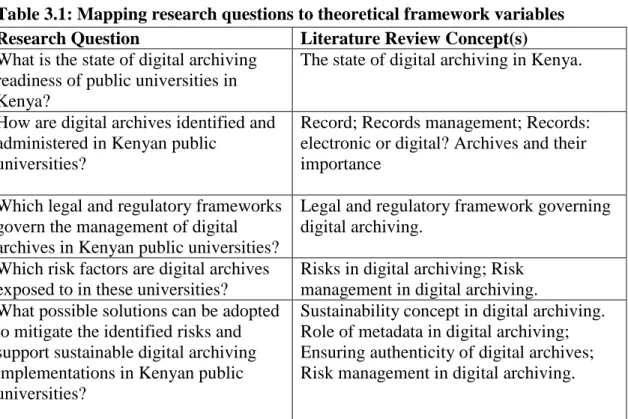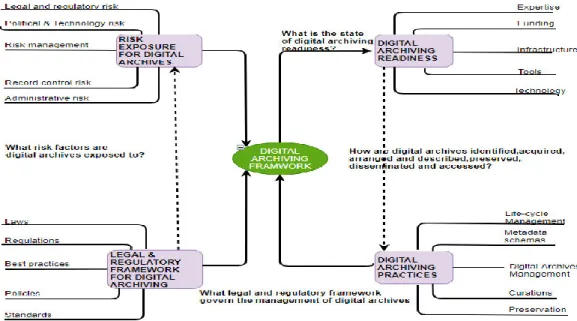The aim of the study was to develop a digital archiving framework for the archive repositories at the institutions. My gratitude goes to the six campuses – University of Nairobi, Jomo Kenyatta University of Agriculture and Technology, Moi, Kenyatta, Maseno and Egerton Universities for allowing me to collect the necessary data.
Introduction
In contrast, digital archiving is the preservation of information in digital form, regardless of the storage medium of that information (Nivel 2014). In the Kenyan scene, the literature reveals that direct digital archiving initiatives have not yet been explored in the country.
Study area
- University of Nairobi (UoN)
- Moi University (MU)
- Kenyatta University (KU)
- Egerton University (EU)
- Maseno University (MSU)
In 1975, Kenyatta College became a department of the University of Nairobi, following an Act of Parliament, changing the name from Kenyatta College to Kenyatta University College. The university offers degree programs in engineering, human resource development, architecture and building science (Jomo Kenyatta University of Agriculture and Technology 2017).
Digital archiving in Kenyan public universities
The history of Maseno University can be traced back to the merger between Maseno Government Training Institute (GTI) and Siriba Teachers Training College, forming Maseno University College under Moi University. Maseno University was established by an Act of Parliament in 1991, and then received its full university status in 2001.
Statement of the problem
Examples of digital records originating from business activities of public universities are financial records, administrative records, personnel records; ICT records;. Literature reveals that public universities in Kenya with the exception of the University of Nairobi lack legal and regulatory frameworks to govern the management of digital records and archives.
Objective of the study
None of these studies holistically examined the legal and regulatory framework for digital archives in public universities. The focus of this research is therefore to determine what is happening in public universities in Kenya with regard to digital archiving and to develop and propose a common framework that can be adopted by these institutions to facilitate the long-term preservation of digital archives. to support.
Delimitations of the study
Therefore, six universities were assumed to have the greatest accumulation of archival collections compared to other institutions in the same category. Given that digital archiving practices at universities are similar due to the similarity of business processes, the findings of the study can be generalized and applied to the archives of other universities.
Significance of the study
The decision helped make the study manageable as the field of data and archive management, although still a developing area, has a rich body of recorded evidence that can prove overwhelming to even the best researchers. The above demarcations in the study were required by financial constraints as the researcher was self-sponsored.
Originality of the study
Contribute to the existing body of literature in a way that has not been done before;. For this to be achieved, the researcher provided critical thinking about the research approach at the beginning of the study.
Discussion of key concepts and terms
- Archives
- Digital archives
- Digital archiving
- Digital archive repositories
- Digital preservation
- Digital curation
- Recordkeeping
- Risk management
The SAL Dictionary of Archives Terminology (2020c) defines digital preservation as the management and protection of digital information to ensure authenticity, integrity, reliability and long-term accessibility. In the context of this study, digital curation will be defined as the active involvement in the long-term preservation, management and use of digital resources.
Models for the study
The ARMA Records Management Maturity Model is based on the Generally Accepted Recordkeeping Principles (GARP) and the legal (regulatory) requirements, best practices and standards around information management. The purpose of this model is to help organizations conduct a preliminary evaluation of their registration programs and practices (Eusch 2016).
Preliminary literature review
This model therefore complements the RC and OAIS models in addressing the study's first and fifth research questions. Document review was used to support the researcher's understanding of the study problem and complement the other data collection tools.
Ethical considerations
Qualitative data were analyzed along themes using NVIVO content analysis software, while quantitative data were analyzed using the Statistical Package for the Social Sciences (SPSS) to generate descriptive and inferential statistics. Interview data and questionnaire data were independently analyzed and then the quantitative results were integrated with the qualitative results in the final discussion.
Structure of the thesis
The chapter provides a summarized discussion of this study's research objectives, methodology, and findings. A detailed discussion of the theories and conceptual framework for the study follows in the subsequent chapter.
Theories, models, theoretical and conceptual framework
Tamene (2016:51) asserts that a theoretical framework is an important and central aspect of research design that guides the researcher on the research process, what to do and how to do it. Therefore, a good theoretical framework guides the researcher in selecting an appropriate methodological approach and analytical tools for the research inquiry.
The use of theories and conceptual frameworks in quantitative, qualitative and mixed methods researches qualitative and mixed methods researches
For example, explanatory mixed methods research designs may use theory deductively in the quantitative phase, then inductively develop broad explanations about the phenomena under investigation in the qualitative phase. The present study employed a mixed-methods approach that includes both qualitative and quantitative approaches, albeit with a qualitative priority.
Theories and theoretical underpinning of the study
Records Continuum (RC) model
- Relevance of the Records Continuum Model to this study
- Gaps in the model
As mentioned earlier, the development of the RC model was in response to the shortcomings of the records lifecycle model. The research endorses the application of the RCM for archive management at archival institutions.
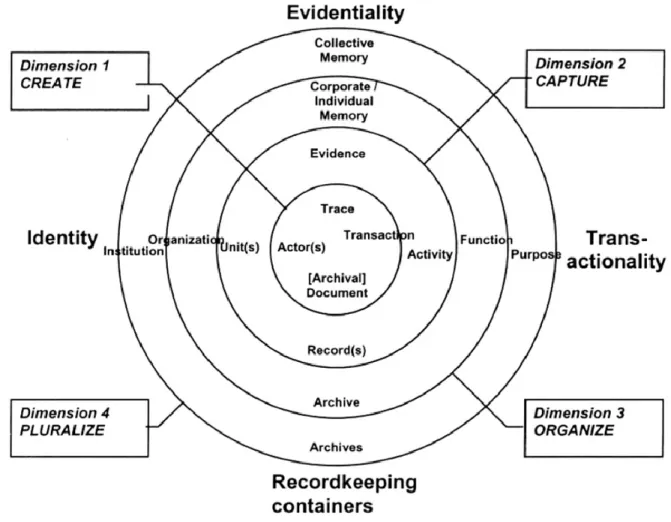
The Open Archival Information System (OAIS) Reference Model
- Suitability of the OAIS Reference model to the study
- Gaps in the OAIS Reference model
This part of the model determines the long-term survival of digital objects in the archive repository. Obtain sufficient control over the information provided to the level necessary to ensure long-term preservation.
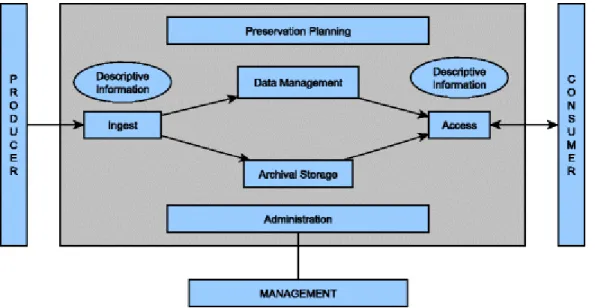
Information Governance (IG) Maturity Models
- The Archives and Records Management Association (ARMA) Records Management Maturity Model Management Maturity Model
ARMA Information Governance Maturity Model (2010) – The model incorporates the Generally Accepted Archiving Principles (GARP) developed by the Archives and Records Management Association (ARMA). The ARMA Records Management Maturity Model is intended to be used as a quality improvement tool (Eusch 2016).
Level 5 (Transformational): The organization has integrated information governance into its overall corporate infrastructure and business processes to the
Proactive): The organization is initiating information governance program improvements throughout its business operations. Information governance issues
Complementary models of the study
- The Records Life Cycle (RLC) model
According to Upward (2001), a life cycle is "the entire series of processes that make up the life history of an organism". Data is defined in the DCC Curation Lifecycle model as "any information in binary digital form".
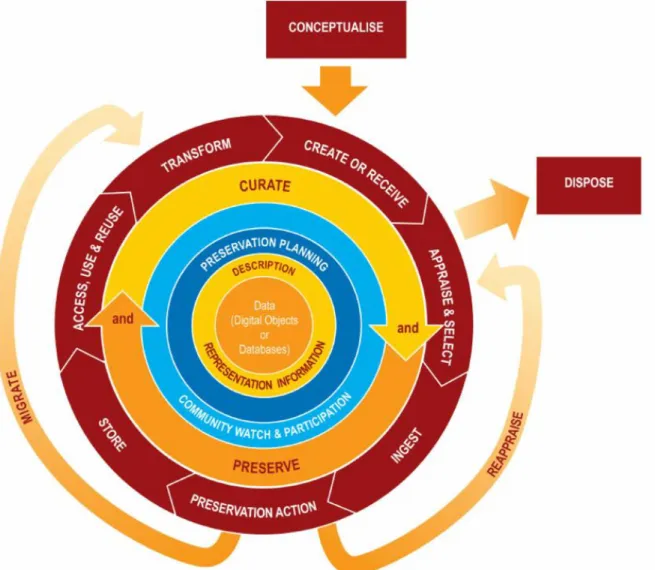
Conceptual framework
- Utility of the conceptual framework in the study
The concepts that emerged from the research questions were embedded in the conceptual framework that was used to guide the literature review and research methodology. The research design is therefore designed in response to the research questions as formulated in the conceptual framework.
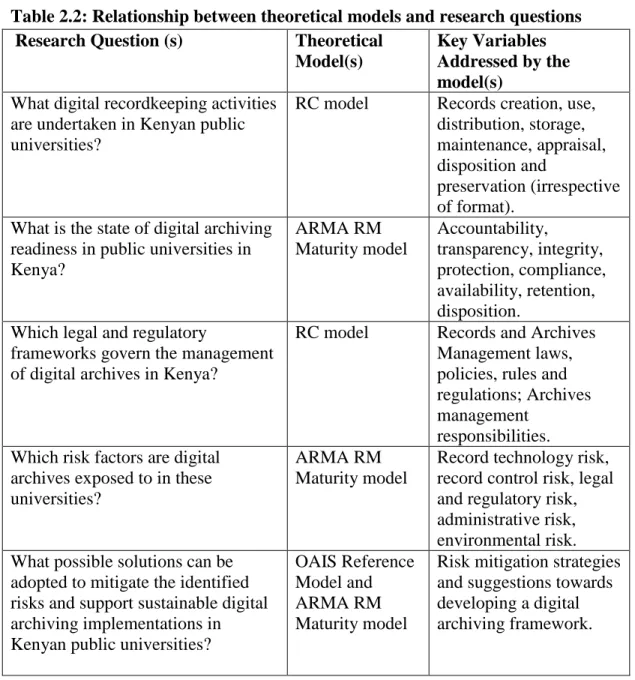
Summary
As implied by Leshem and Trafford, the conceptual framework connects the study to its conceptual conclusions. Literature review topics shed light on the research problem and are helpful in addressing the study's research questions.
Introduction
Literature review in research
The importance of conducting a literature review as part of research cannot be overemphasized, but the process of conducting it remains a debatable topic. Boell and Cecez-Kekmanovic described the literature review process as including the stages of literature search, selection, and synthesis.
Literature review map
The researcher used mind maps and concept maps to develop a literature review map for this study, which was used to enable the organization and abstraction of relevant information from various sources. The ideas in the two models were brought together by the researcher to come up with the literature review map for the current study (Figure 3.3).
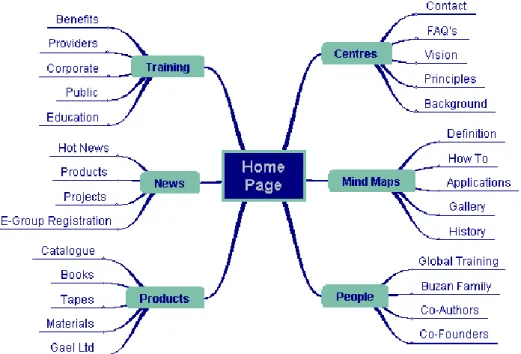
Review of literature based on the main themes of the study
- Digital records management
- Digital archives management
Baron and Thurston (2016), Duranti (2010, Cumming and Findlay (2010) and Caplan (2010) suggested sustainable solutions and strategies for effective management of digital records and archives. Ngoepe and Saurombe (2016) stated that legislation has an enormous impact on the management of digital records and archives in a country.
Digital Archiving Readiness
- ICT infrastructure
- Resources for digital archiving
Literally speaking, the 'elephant in the house' with regard to the management of information in organizations is preparedness for digital records management. ICT infrastructure is an important driver for the management of digital records and archives in public sector organisations.
Digital Archives Identification and Administration
- Digital archiving practices
- Creation
- Acquisition: selection and appraisal of archives
- Accessioning of Archives
- Arrangement and description of archives
- Storage and preservation of digital archives
- Preserving digital archives in the cloud
- Preserving authenticity, integrity and reliability in digital archives
- Access to digital archives
- The archivist’s role in digital archiving
Lack of trained staff or experienced professionals in managing and preserving digital resources; And. The authenticity, integrity and reliability of documents are fundamental to the digital preservation process and are very important in the archival world (Bhebhe because documents can only be trusted if these characteristics can be demonstrated, despite periodic migration between digital media, hardware and software (Ismail and Jamaludin 2009: 137).
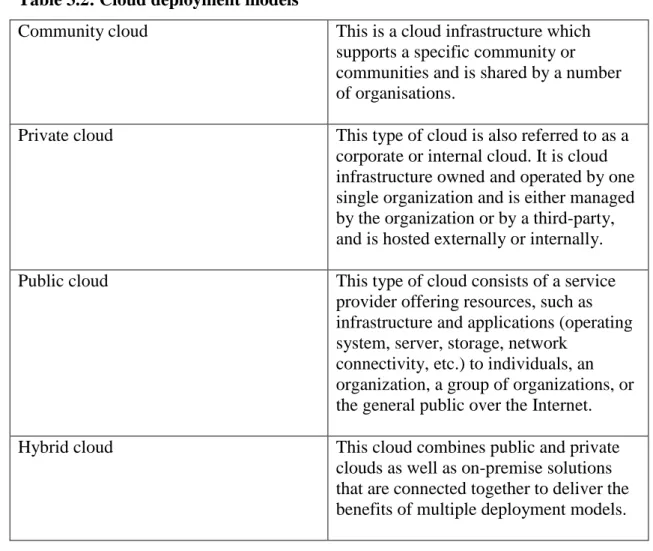
Legal and regulatory frameworks governing digital archives
- Access to information laws
- Privacy laws
- Policies
- Standards and best practices
Highlighting the findings of the investigation, Ambira Kabata noted that the Public Archives Act Cap 19 did not explicitly address the management of digital archives. The two studies recommended a review of the law to integrate definitions of digital records and archives and to address digital registration procedures comprehensively (Kabata 2019:111; IRMT 2011).
Risk factors for digital archives in universities
African countries, including Kenya, have not been expanded, possibly due to the slow development of digital archiving on the continent. Record Control Risks: There is a potential risk of information loss if files are not properly sorted and named.
Sustainable digital archiving
An analysis of the identified risks is then carried out by mapping the risks to the warehouse objectives to determine the severity of the risks faced. Following the widespread acceptance of the concept of trusted digital repositories, archival repositories are increasingly embracing the OAIS model approach proposed by IRMT (2009:23) where a number of similar digital archival repositories are brought together by combining and sharing their resources with the common goal of managing and providing access to their individual digital archives from a central point (the Trusted Digital Archive).
Gaps in scholarship: empirical, theoretical and methodological shortcomings
This ties in with the current study that examines risks to digital archives as an important part of the study. The study provided insight into the methodology and understanding of the depth of records management in the public sector in Uganda.
Introduction
Thus, researchers should carefully consider the available methodological options and select the most appropriate strategies that will lead to solving the research problem under investigation (Alford 1998: 25). Using the research methodology map below (Figure 4.1), this chapter presents a discussion of the research philosophy and methodology used in conducting this research.
Research paradigms
Paradigms as shared beliefs among members of a particular field (referring to the nature of questions and answers in the field of research; and. Paradigms as exemplary cases of research (depending on existing typical examples of the best solutions to problems).
Paradigms
Research methods
Interpretive Sequential Mixed Methods – In this approach, the researcher begins by collecting data using a quantitative approach, then analyzes and interprets the findings qualitatively (thus using interpretation). Embedded (Convergent Parallel) Mixed Methods – In this type of MMR, the researcher converges or combines qualitative and quantitative data to provide a complete analysis of the research problem.
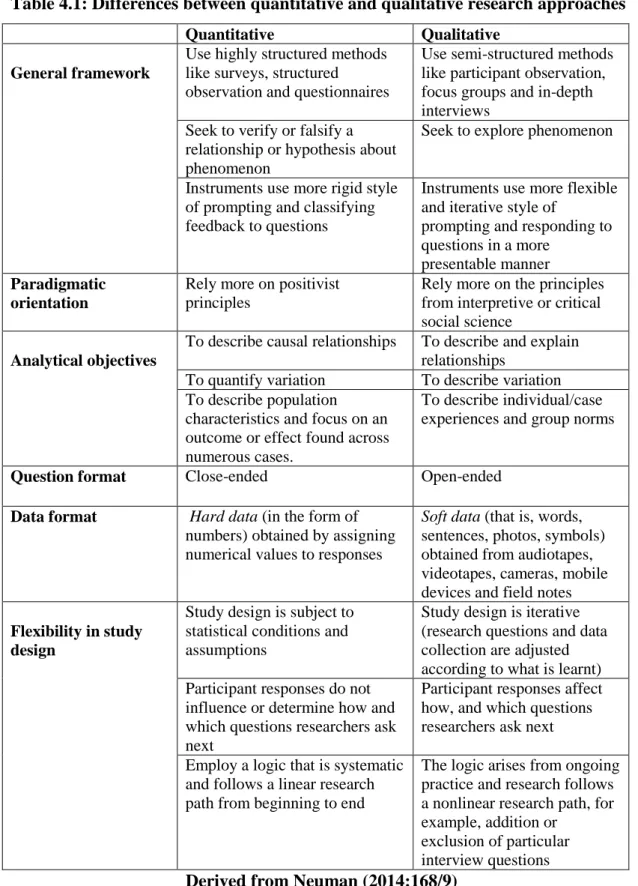
Research design
- Case study design
- Survey design
McKemmish and Gilliland believe that in-depth single-case or multi-case studies are appropriate for investigating current record-keeping practices. This study adopted a (embedded) multiple case design, described as case study research, comprising several instrumentally limited cases carefully selected to develop a deeper and better understanding of the phenomenon than a single case study can provide (Encyclopedia Research Case Study 2010:584 ).
Study population
The FO was in a position to respond to questions related to funding for digital recordkeeping in the university;. ICT Director – He/she is responsible for technology-related issues in the university and reports directly to the VC.
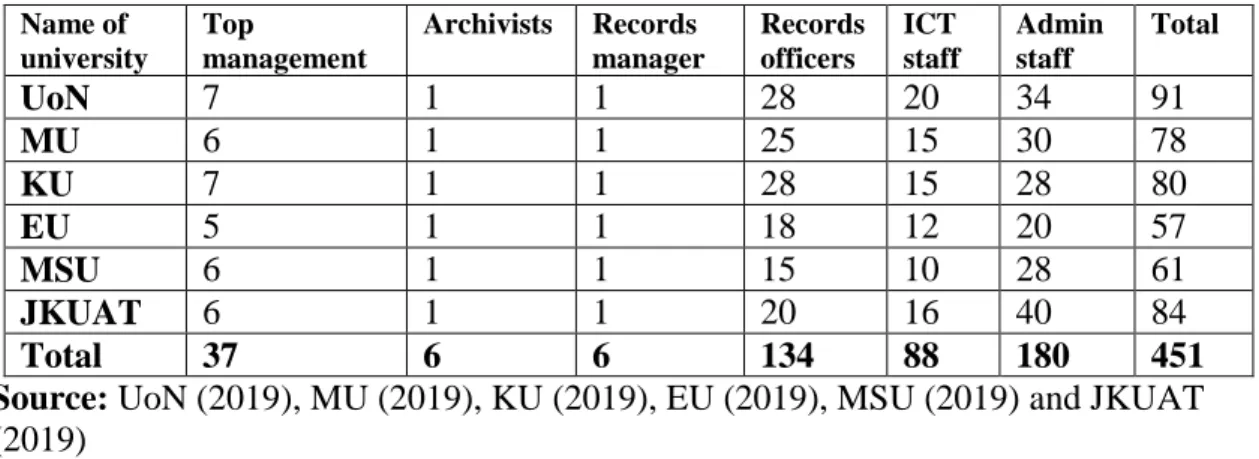
Sampling procedure
They were selected to participate in the study because they are involved in decision-making about the creation, management and disposal of documents at the school/faculty level. Stratified and purposive sampling methods were then used to select respondents from 6 categories (stratums) to participate in the study.
Data collection methods
- Questionnaire
- Interview
Given that this is a mixed study in the COVID-19 era, data collection procedures were triangulated across and between methods. Burke and Christensen define a questionnaire as a self-report data collection tool that is completed by research participants as part of the study.
